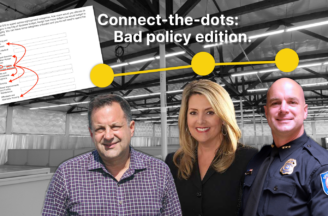
SCAR
Why not try real solutions?
Spokane could just decide to love its community more. Everyone wants less crime, but leaning on police to do all the work just creates more prisoners. We need to actually invest in our community; in each other.
Search
Important Updates
The Spokane County Board of Commissioners will soon have five members, rather than three. To accommodate this shift, district lines are being redrawn to divide the county into five sections–a process known as redistricting. The new districts will, ideally, better reflect the area’s shifting population.
Redistricting happens every ten years, in conjunction with new numbers from the U.S. Census. In addition, a recent change in state law requires counties with more than 400,000 residents to be represented by a commission of five members. Spokane County has a population of more than 541,000.
State law requires that commissioner districts be as equal in population as possible and as compact as possible, meaning that constituents within a district should live as near to one another as is feasible. With five districts, each should contain about one-fifth of the county’s population, which is roughly 108,000 in Spokane County. Each district must be geographically contiguous (areas within the district must be physically adjacent), and district boundaries should coincide with existing geographic boundaries–like the Spokane River, I-90, and the North-South Corridor–as well as election precinct boundaries.
The redistricting process is being overseen by the five-member, bipartisan Spokane County Independent Redistricting Committee (IRC).
The IRC recently released four draft maps based on community input, committee discussions, and demographic information. Each of the IRC’s four draft map scenarios presents challenges in terms of equity.
Scenario A lumps much of the City of Spokane into a single district, while splitting communities on the edge of the city among the remaining districts. This approach doesn’t consider the differing needs of neighborhoods within the city, and it uses no existing physical boundaries to draw its lines. Committee members have said that they aren’t strongly considering Scenario A.
Scenario B does a better job of dividing the city along existing borders, but it awkwardly creates a single U-shaped district that wraps from the Spokane River on the western side of the county, south through Fairchild AFB and Medical Lake, across south Spokane County, and back up to include part of Spokane Valley and all of Liberty Lake. Those areas share little in the way of location, growth issues, or political demographics.
Scenario C again splits Spokane Valley into two districts, neither of which includes its neighbor, Liberty Lake. Instead, Liberty Lake is in the same district as Mead, Elk, and Deer Park, communities it is not in close proximity to.
Scenario D groups a portion of the city’s North Side with the downtown corridor and the South Hill–areas which have traditionally had different interests and issues. Spokane clearly has a north-south divide, both in terms of values and in terms of geography, and an equitable approach to commissioner districts should reflect this.
The Coalition for Creating 5 Fair, Equitable Spokane County Commissioner Districts, a broad group of community members, has proposed a more equitable map. This map groups together communities of interest– groups with shared political, economic, or social concerns– using existing boundaries to avoid splitting neighbors into different districts. Using such logic in its proposal, the Coalition strives to increase the representation of Black, Indigenous, and People of Color voters and create competitive and fair districts with leaders who are accountable and responsive to their districts’ growth-related challenges at the edge of urban areas.
The IRC recently received data from the 2020 census, and this data, along with further public input, will go into what the IRC submits as its final plan by October 23.
The IRC will hold its second of three public hearings on September 16, 2021, at 5:30 p.m. at the Moran Prairie Public Library. Any person may provide up to three minutes of testimony in person or by Zoom.
There remains one more public information session at the Cheney Public Library on September 30, and a final public hearing on October 7 at Northern Quest. In addition to these public events, all held from 5:30-7:30 p.m., people can also comment by e-mail to info@redistrictspokaneco.com, by mail to P.O. Box 31508 Spokane, WA 99223, or by attending IRC weekly meetings at the Spokane Arena, also with a Zoom option, Tuesdays from 4:30-6:30 p.m. These opportunities are some of the last to give input promoting equity at this important moment in Spokane’s history.